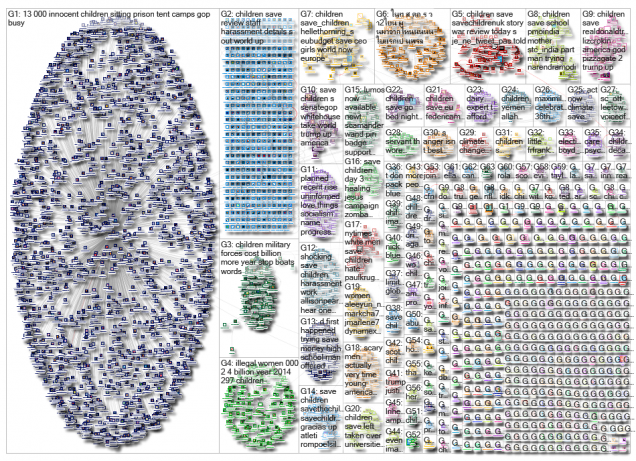The first graph that I chose represents users who’s tweets included “save the children” or who were replied to or mentioned in those tweets. This graph is an example of what Smith et al. identified as a community cluster.
https://nodexlgraphgallery.org/Pages/Graph.aspx?graphID=171229

Save the Children is an international nonprofit that promotes human rights for children and provides support to children in developing countries. Community clusters are formed around global events and popular topics. Although they may be speaking about the same topic, they are generally disconnected from one another, in some cases by the formation of specific subtopics and in others by their individual news sources. From the users and hashtags mentioned we see that Save the Children’s pages are popular, which can lead us to assume that they are providing much of the information that users are interacting with. This can lead to a very controlled flow of information if only the organization itself is providing any information to interested users. Self reported information would always be biased towards the organization in such ways as overlooking any potentially questionable practices, a continued favorable evaluation of their outcomes, and similar self promotions. However, with community clusters Smith et al. explains that “global news stories often attract coverage from multiple news outlets each with its own following.” Which in turn helps create these small groups of individuals who are receiving information from the same places and often have similar opinions. By creating many smaller groups more diverse opinions of the topic are formed based on relevant audiences. This can be observed in the above graph when looking at the variety of hashtags used.
While many of the mentioned users are some variation of Save the Children accounts, the hashtags express a variety of interests in the topic. The hashtag #children, is probably relevant to most users who wish to share something about the topic. However, from there they become more niche with users developing specific conversations about aspects of the nonprofit that may be relevant or interesting to them. Particular countries are mentioned as well as political hashtags like #eubudget and #mogherini.
The next graph I have chosen represents connections between Twitter users who either tweeted or were mentioned in tweets using the hashtag #some4surgery.

https://nodexlgraphgallery.org/Pages/Graph.aspx?graphID=171256
#SoMe4Surgery is a hashtag used to facilitate conversations about surgical training and colorectal surgery. This graph exemplifies a tight crowd as explained by Smith et al. A tight crowd is characterized by highly interconnected participants which usually discuss topics such as professional practices, and hobby groups. (Smith et al. 2014) This conversation is facilitated by doctors discussing new surgical practices.
These structures of tight crowds are typical of professional communities and can show how networked learning communities function. The communities function on social media and create specialty groups within larger platforms showing how sharing and mutual support can be facilitated by social media. The highlighted members of this group consist primarily of medical professionals, and the hashtags are on target with the main topic. These two characteristics are expected of a tight crowd due to the nature highly interconnected nature of the crowd, which leads to a specialized topic. A community such as this easily facilitates community learning by collaboratively sharing information from the many sources in the group. With many users sharing the same practical knowledge, they are able to focus on nuances and evolution in the topic to co-create new meanings and further group knowledge.
These networks exemplify how social media has changed content creation online. It is easy to create groups and facilitate discussion online because of the ease of connecting with others. “Paths where only recognized experts would once tread are now open noncredentialed amateurs.” (Rainie and Wellman, 2012) In the first case, people are able to form groups and collaboratively create content for a specific cause. This collaboration allows for interaction in an area usually reserved for the likes of celebrities. The job of raising awareness, rallying troops, and encouraging donations, is something that celebrity sponsors are typically employed to do. While the main participants in SoMe4Surgery are doctors and surgeons, who we assume have some credentials, the platform still allows for everyone to be involved in the discussion. The open nature also allows for medical practitioners of all levels to engage in discourse rather than abiding by the hierarchy that exists in many hospitals and conferences in which younger members must work hard to gain credibility and awareness despite having as much training. On a site where everyone is equal, knowledge is built collaboratively with all members of the field who choose to participate.
Both Twitter conversations are examples of the ways that online users share information and facilitate discussion to create communities of various sizes and types.
Rainie, H., & Wellman, B. (2012). Networked: The new social operating system. Cambridge, MA: MIT Press.
Smith, M. A., Rainie, L., Shneiderman, B., & Himelboim, I. (2014, February 21). Mapping Twitter Topic Networks: From Polarized Crowds to Community Clusters | Pew Research Center. Retrieved from http://www.pewinternet.org/2014/02/20/mapping-twitter-topic-networks-from-polarized-crowds-to-community-clusters/